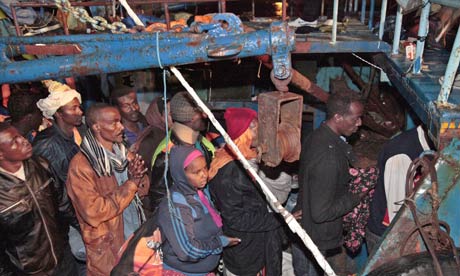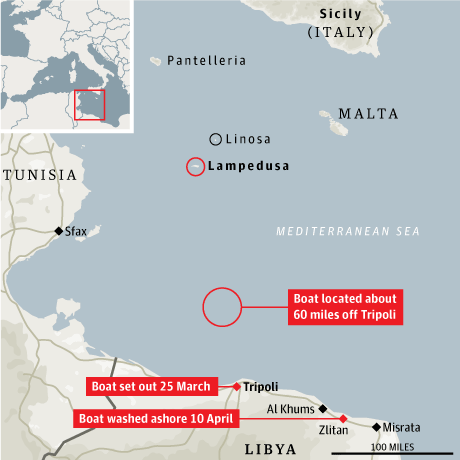Nato units left 61 African migrants to die of hunger and thirst
![]()
Exclusive: Boat trying to reach Lampedusa was left to drift in Mediterranean for 16 days, despite alarm being raised

Refugees from Libya reach Lampedusa. A Nato ship failed to rescue a boat in trouble – leaving 61 people on board to die. Photograph: Francesco Malavolta/EPA
Dozens of African migrants were left to die in the Mediterranean after a number of European and Nato military units apparently ignored their cries for help, the Guardian has learned.A boat carrying 72 passengers, including several women, young children and political refugees, ran into trouble in late March after leaving Tripoli for the Italian island of Lampedusa. Despite alarms being raised with the Italian coastguard and the boat making contact with a military helicopter and a Nato warship, no rescue effort was attempted.
All but 11 of those on board died from thirst and hunger after their vessel was left to drift in open waters for 16 days. “Every morning we would wake up and find more bodies, which we would leave for 24 hours and then throw overboard,” said Abu Kurke, one of only nine survivors. “By the final days, we didn’t know ourselves … everyone was either praying, or dying.”
International maritime law compels all vessels, including military units, to answer distress calls from nearby boats and to offer help where possible. Refugee rights campaigners have demanded an investigation into the deaths, while the UNHCR, the UN’s refugee agency, has called for stricter co-operation among commercial and military vessels in the Mediterranean in an effort to save human lives.
“The Mediterranean cannot become the wild west,” said spokeswoman Laura Boldrini. “Those who do not rescue people at sea cannot remain unpunished.”
Her words were echoed by Father Moses Zerai, an Eritrean priest in Rome who runs the refugee rights organisation Habeshia, and who was one of the last people to be in communication with the migrant boat before the battery in its satellite phone ran out.
“There was an abdication of responsibility which led to the deaths of over 60 people, including children,” he claimed. “That constitutes a crime, and that crime cannot go unpunished just because the victims were African migrants and not tourists on a cruise liner.”
This year’s political turmoil and military conflict in north Africa have fuelled a sharp rise in the number of people attempting to reach Europe by sea, with up to 30,000 migrants believed to have made the journey across the Mediterranean over the past four months. Large numbers have died en route; last month more than 800 migrants of different nationalities who left on boats from Libya never made it to European shores and are presumed dead.
-
Underlining the dangers, on Sunday more than 400 migrants were involved in a dramatic rescue when their boat hit rocks on Lampedusa.
The pope, meanwhile, in an address to more than 300,000 worshippers, called on Italians to welcome immigrants fleeing to their shores.
The Guardian’s investigation into the case of the boat of 72 migrants which set sail from Tripoli on 25 March established that it carried 47 Ethiopians, seven Nigerians, seven Eritreans, six Ghanaians and five Sudanese migrants. Twenty were women and two were small children, one of whom was just one year old. The boat’s Ghanaian captain was aiming for the Italian island of Lampedusa, 180 miles north-west of the Libyan capital, but after 18 hours at sea the small vessel began running into trouble and losing fuel.
Using witness testimony from survivors and other individuals who were in contact with the passengers during its doomed voyage, the Guardian has pieced together what happened next. The account paints a harrowing picture of a group of desperate migrants condemned to death by a combination of bad luck, bureaucracy and the apparent indifference of European military forces who had the opportunity to attempt a rescue.
The migrants used the boat’s satellite phone to call Zerai in Rome, who in turn contacted the Italian coastguard. The boat’s location was narrowed down to about 60 miles off Tripoli, and coastguard officials assured Zerai that the alarm had been raised and all relevant authorities had been alerted to the situation.
Soon a military helicopter marked with the word “army” appeared above the boat. The pilots, who were wearing military uniforms, lowered bottles of water and packets of biscuits and gestured to passengers that they should hold their position until a rescue boat came to help. The helicopter flew off, but no rescue boat arrived.
No country has yet admitted sending the helicopter that made contact with the migrants. A spokesman for the Italian coastguard said: “We advised Malta that the vessel was heading towards their search and rescue zone, and we issued an alert telling vessels to look out for the boat, obliging them to attempt a rescue.” The Maltese authorities denied they had had any involvement with the boat.
After several hours of waiting, it became apparent to those on board that help was not on the way. The vessel had only 20 litres of fuel left, but the captain told passengers that Lampedusa was close enough for him to make it there unaided. It was a fatal mistake. By 27 March, the boat had lost its way, run out of fuel and was drifting with the currents.
“We’d finished the oil, we’d finished the food and water, we’d finished everything,” said Kurke, a 24-year-old migrant who was fleeing ethnic conflict in his homeland, the Oromia region of Ethiopia. “We were drifting in the sea, and the weather was very dangerous.” At some point on 29 or 30 March the boat was carried near to a Nato aircraft carrier – so close that it would have been impossible to be missed. According to survivors, two jets took off from the ship and flew low over the boat while the migrants stood on deck holding the two starving babies aloft. But from that point on, no help was forthcoming. Unable to manoeuvre any closer to the aircraft carrier, the migrants’ boat drifted away. Shorn of supplies, fuel or means of contacting the outside world, they began succumbing one by one to thirst and starvation.
The Guardian has made extensive inquiries to ascertain the identity of the Nato aircraft carrier, and has concluded that it is likely to have been the French ship Charles de Gaulle, which was operating in the Mediterranean on those dates.
French naval authorities initially denied the carrier was in the region at that time. After being shown news reports which indicated this was untrue, a spokesperson declined to comment.
A spokesman for Nato, which is co-ordinating military action in Libya, said it had not logged any distress signals from the boat and had no records of the incident. “Nato units are fully aware of their responsibilities with regard to the international maritime law regarding safety of life at sea,” said an official. “Nato ships will answer all distress calls at sea and always provide help when necessary. Saving lives is a priority for any Nato ships.”
For most of the migrants, the failure of the Nato ship to mount any rescue attempt proved fatal. Over the next 10 days, almost everyone on board died. “We saved one bottle of water from the helicopter for the two babies, and kept feeding them even after their parents had passed,” said Kurke, who survived by drinking his own urine and eating two tubes of toothpaste. “But after two days, the babies passed too, because they were so small.”
On 10 April, the boat washed up on a beach near the Libyan town of Zlitan near Misrata. Of the 72 migrants who had embarked at Tripoli, only 11 were still alive, and one of those died almost immediately on reaching land. Another survivor died shortly afterwards in prison, after Gaddafi’s forces arrested the migrants and detained them for four days.
 The route of the boat
The route of the boat Despite the trauma of their last attempt, the migrants – who are hiding out in the house of an Ethiopian in the Libyan capital – are willing to tackle the Mediterranean again if it means reaching Europe and gaining asylum.
“These are people living an unimaginable existence, fleeing political, religious and ethnic persecution,” said Zerai. “We must have justice for them, for those that died alongside them, and for the families who have lost their loved ones.”
Additional reporting by John Hooper and Tom Kington in Rome, and Kim Willsher in Paris
• This article was amended on 9 May 2011. The picture caption used the wrong figure for the death toll. This has been corrected.
Related Articles
Contra la Bastilla
![]()
Día de la Bastilla y en algunos lugares del país hay quienes se movilizan a pesar de los muros fronterizos,
Londres avala que Escocia sea Estado si la independencia gana en 2014
![]()
HACIA EL REFERÉNDUM DE 2014 Un informe del Gobierno Cameron aclara que este será el único desenlace: «Esto es demasiado
Deaths reported in ‘fresh Syrian assault’
![]()
At least 21 killed in tank-backed raid on Homs, a day after 2,000 people held anti-regime protests, activists say A


